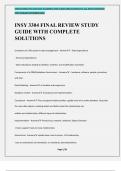EMILLYCHARLOTTE 2024/2025 ACADEMIC YAER ©2024 EMILLYCHARLOTTE. ALL RIGHTS RESERVED
FIRST PUBLISH SEPTEMBER 2024
INSY 3304 FINAL REVIEW STUDY
GUIDE WITH COMPLETE
SOLUTIONS
Limitations of a file system in data management - Answer✔✔-- Data dependence
- Structural dependence
- Data redundancy leading to deletion, insertion, and modification anomalies
Components of a DBMS/database Environment - Answer✔✔-- hardware, software, people, procedure,
and data
Data Modeling - Answer✔✔-is iterative and progressive
Database models - Answer✔✔-Conceptual and Implementation
Conceptual - Answer✔✔-The conceptual model provides a global view of an entire database. Describes
the main data objects, avoiding details and define what the relationships are.
entities and relationships, different types of relationships
Implementation - Answer✔✔-hierarchical, network, relational, Object Oriented
-It does support many to many relationships
Hierarchical - Answer✔✔-upside down tree structure, 1-M relationship
-easy to understand, but drawbacks: no standards, data dependency
Page 1/18
,EMILLYCHARLOTTE 2024/2025 ACADEMIC YAER ©2024 EMILLYCHARLOTTE. ALL RIGHTS RESERVED
FIRST PUBLISH SEPTEMBER 2024
Network- - Answer✔✔-upside down tree structure, supports M-M relationships
-standards, but data dependency, difficult to implement because of the many to many
Object Oriented - Answer✔✔-data becomes active component of system using methods and attributes
-You can use these Code reuse, polymorphism, encapsulation in the database
Relational: - Answer✔✔-still most popular dbms model
Different levels of data models - Answer✔✔-Conceptual, Internal, External, Physical
Conceptual Database model - Answer✔✔-The output of the conceptual design process. The conceptual
model provides a global view of an entire database. Describes the main data objects, avoiding details.
-highest level, contains least detail, not hardware or software dependent.
internal Database model - Answer✔✔-refers to a level of data abstraction that adapts the conceptual
model to a specific DBMS model for implementation.
-adapt conceptual model to dbms that's chosen.
External Database model - Answer✔✔-The application programmer's view of the data environment.
Given its businessunit focus, an external model works with a data subset of the global database schema.
-both are software dependent, gives a breakdown of model into functional units
Physical Database model - Answer✔✔-model in which the physical characteristics (location, path, and
format) are described for the data. Both hardware- and software-dependent.
-mapping out how to get to data, access paths,
Page 2/18
, EMILLYCHARLOTTE 2024/2025 ACADEMIC YAER ©2024 EMILLYCHARLOTTE. ALL RIGHTS RESERVED
FIRST PUBLISH SEPTEMBER 2024
Basic concepts about the relational database model - Answer✔✔-entities, attributes, tables, rows,
columns, domain of an attribute, cardinality, connectivity
Entity - Answer✔✔-person place or thing that you want to store data about (represented as a table or
relation)
+represented by rectagle
Attributes - Answer✔✔-characteristic or property of the data or of the entity, stored as columns
+represented by ovals
+property of an entity and stored in a table
• Row table - Answer✔✔-instance of an entity each row is an instance
+represent a record in a file
• Column - Answer✔✔-represent the attribute
+represent a field in a file
• Attribute domain - Answer✔✔-specifies possible range of values
• Cardinality - Answer✔✔-Expresses minimum and maximum number of entity occurrences associated
with one
occurrence of related entity(sort of like a range)
• Connectivity - Answer✔✔-Describes the relationship classification (type)
Types of Functional dependency: - Answer✔✔-Full, partial, transitive
Page 3/18




